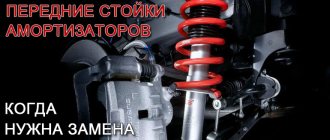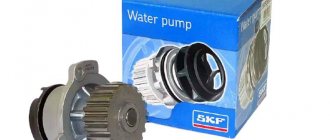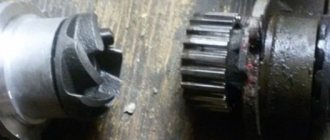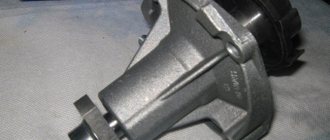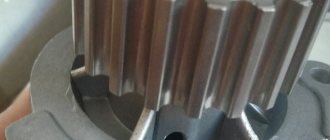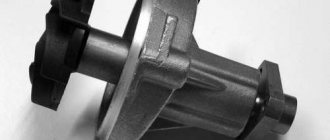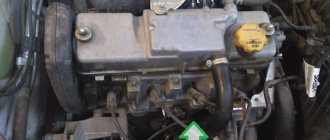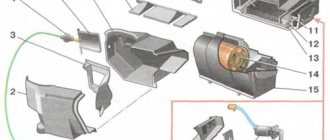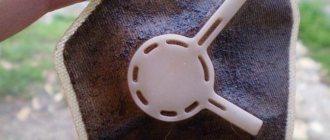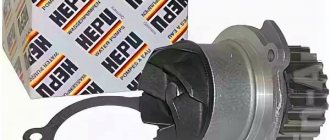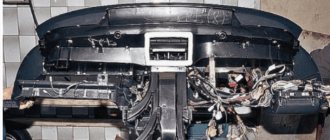The water pump (water pump) of the engine cooling system is an important component that ensures constant circulation of coolant through the channels of the cooling jacket, pipes, lines, cooling radiator, etc. Even a slight decrease in the performance of a car pump can cause the engine to overheat, especially in the warm season.
We also recommend reading the article about the design of the cooling system water pump. From this article you will learn about the operating principles and design features of the pump.
Another reason to check whether the pump is working or not is possible extraneous noise in the water pump drive. In this case, the specified pump requires increased attention on some car models. The fact is that the pump can be driven by the timing belt. If the water pump jams, then the timing belt breaks, resulting in valve bending on most engines. Next, we will look at the available methods that allow you to check the water pump yourself.
Symptoms of malfunction
- Pump noise when the engine is running. Extraneous noise is caused by bearing wear. It is recommended to replace the cooling system pump after one or every time replacement. If maintenance intervals are not observed, the rolling elements, inner and outer rings will wear, causing noise and whistling. Quite often, the cause of accelerated wear is antifreeze, which gets into friction pairs due to leakage of oil or rubber seals.
- Antifreeze leak. Like the pump bearing, the oil seal and rubber bushing have a limited service life. Play due to bearing wear will result in much less sealant leakage.
- Misalignment with respect to gears, shafts (pump is misaligned). Uneven stress distribution causes accelerated wear not only of the bearing, but also of the seal. Incorrect assembly or manufacturing defects, when the pulley rotates misaligned, leads to accelerated wear of the loaded part of the belt. Such a malfunction, even with low mileage, can break the timing belt and break valves with pistons.
- Engine overheating. When the impeller vanes break, the pump's performance drops, resulting in less coolant flow through the small circulation circuit.
A decrease in performance is often noticeable after applying sealant to repair a radiator leak. The mixture clogs the cooling system passages and sticks to the pump impeller.
Unless grease has clogged the body coolant drain, leaking sealant will not cause water pump failure. However, it is necessary to disassemble the pump and flush the system.
Technical features
First, let's look at the main technical characteristics and features of the water pump; this will allow us not only to make a correct diagnosis, but also to understand why the breakdown occurred.
Antifreeze is pumped using an impeller, which is mounted on a shaft. The drive is carried out from the crankshaft of the motor; a belt drive is used for this. Here it is worth clarifying that in practice there are 2 drive methods used for the pump:
- Directly from the crankshaft
. This method is used on engines with a timing chain. Usually one belt drives the generator and pump, sometimes the power steering and air conditioning pump are also connected here; - Another option is timing belt drive.
There is one serious drawback here. When the bearing jams in the pump, the belt breaks, which leads to breakdown of the gas distribution system, and under certain conditions, to a complete overhaul of the engine. In this case, you should carefully monitor the condition of the pump.
The pump housing is usually located at the front of the motor. This allows for the most optimal pumping of coolant through the system. It is also precisely this approach that makes it possible to use the crankshaft pulley as a moving element. In addition, placing the part at the front makes it easier to access for repairs.
The main malfunctions of the pump are directly related to its technical features; accordingly, this must be taken into account when carrying out diagnostic actions. As a rule, all signs of a malfunction are completely related to the characteristics of the various elements that ensure the operation of your car's cooling system.
How to check the cooling system pump?
By checking the pump without removing it from the engine, we can only indirectly assess its efficiency. With a reduced volume of pumped coolant, the heating element begins to warm up poorly. But before disassembling the water pump to check the impeller, we recommend checking the thermostat and making sure there is no air blockage in the cooling system.
After disassembly, you should pay attention not only to the integrity of the blades and the impeller seat on the drive shaft, but also to the shape of the blades. For example, on the VAZ 2121 over many years of production, rotors of different diameters, numbers and shapes of blades were installed. Installing a less efficient pump in an engine with a higher thermal load will result in the cooling fan running more frequently and an increased risk of overheating.
Be sure to check the engine block in the housing area and the pump itself. Fogging or a slight coolant leak from the drain hole does not mean the pump needs to be replaced. If you find a significant leak, try to find it. If the leak is only in the area of the housing adjacent to the engine block, most likely it can be fixed without replacing the pump. Simply apply sealant and install a new gasket.
Risk of timing belt breakage
The danger of a misaligned water pump sprocket is when there are no obvious signs of trouble. The first thing you should pay attention to is the timing belt. If uneven wear is observed in any case, check the pump and shafts. The cause of misalignment may be a manufacturing defect, worn bearings, or uneven contact between the housing and the cylinder block (dirty, rusty seating surfaces). Sometimes the malfunction begins to appear after an accident, when parts of the body or installed equipment get into the pump pulley.
If you find misalignment, replace the damaged pump as soon as possible. Do not hesitate to also eliminate noise and whistling from the water pump. In case of critical wear, the bearing may fail, blocking the gear. A stuck pump will definitely break the timing belt. If the pistons in your car encounter valves when they break, repairing the damage will cost quite a lot of money.
Bearing check
The easiest way to check the pump is to ensure that the pulley is in an accessible place and can be turned by the drive belt. Just take the pulley in your hand and move it in different directions (watch the video). If it breaks, you will feel a lot of weakness. To determine whether the whistling noise when the engine is running is coming from the coolant pump, remove the drive belt and unwind the pulley by hand. A worn bearing with washed out lubricant will rotate and turn over with noticeable noise.
Checking the pump, the pulley of which rotates the timing belt, is a little more difficult. Once you overcome the belt tension, you can try moving the sprocket in different directions. But in order to fully check and evaluate the smoothness of rotation, the timing belt will still have to be loosened.
The main cause of breakdowns
If the seal or rubber flange leaks, the coolant washes the lubricant out of the bearings. The problem will get worse if you use cheap toluene or water instead of high-quality antifreeze. The lack of anti-corrosion additives and minimal lubricity will very quickly “kill” the pump bearing.
However, it is much more important to use a good quality antifreeze to ensure the long life of the sealant. At the point of contact with the drive shaft, it is necessary to lubricate the rubber seals, which cannot be said when using aggressive toluene or water.
Causes of water pump failure
The pump in a car can fail for various reasons. Let's list the most common ones:
- low quality coolant. Approximately 90% of water pumps in passenger cars break down due to poor antifreeze. Poor quality coolant leads to the formation of tarry deposits, which impede the rotation of the impeller. It can also cause corrosion of the internal parts of the pump. And low-quality antifreeze can cause an increased level of cavitation, when vacuum bubbles formed during rotation of the impeller collapse and literally tear out steel particles from the inner surface of the pump, which leads to rapid destruction of the device;
The inside of the water pump is destroyed due to cavitation - natural wear and tear. Any device can simply exhaust its resource. And the water pump is no exception in this regard. The average service life of a water pump is 200 thousand kilometers. After this, it should be checked without fail and, in case of severe wear, replaced;
- problems with fasteners. The bolts that secure the pump to the engine housing become loose over time. Since the pulleys are constantly rotating, when the fastening bolts on the pump shaft are loosened, play inevitably occurs, which increases as the mileage progresses. Eventually this will either damage the pump shaft or destroy the center bearing.
The central pulley shaft of the pump has worn out due to constant play.
Where to begin?
There are some signs of failure of the VAZ pump. In these models, the pump ensures the passage of antifreeze through the cooling jacket, hoses and pipes, as well as through the radiator. During the warm season, even a slight malfunction of the pump can lead to overheating.
It is worth noting that the symptoms of a pump malfunction on the VAZ-2112, 2107, 2109, 2114 and some other models should be determined as soon as possible. The fact is that in these models the pump is driven by a timing belt. If the pump jams for any reason, it will fail. This, in turn, leads to deformation of the valves in the engine. This situation occurs in most cases when such a failure occurs. Therefore, it is important to independently identify signs of pump failure in the cooling system.
Knowing the symptoms of failure of the VAZ-2114, 2112 or earlier models, you can avoid expensive engine repairs or constant overheating.
It is worth noting that the cooling system water pump has a certain service life. Once the expiration date has passed, this system component must be replaced. In cars with a pump driven by a timing belt, this element of the system should be replaced every 60 thousand. km mileage This distance is usually around 48 months (with regular driving).
Is there any point in renovation?
Of course, almost any spare part can be repaired, but the question is the feasibility of this idea. We do not recommend repairing the pump, since its cost is not exorbitant. In addition, it is extremely undesirable to restore the pump on cars in which the pump is connected to the timing belt. Otherwise, you risk a very serious risk, since a jammed pump can lead to a broken belt. And this is already fraught with dire consequences for the engine, requiring significant investments.
Why does the pump break down?
Before dealing with the signs of a malfunction of the pump 2110, 2107 or other models, you should pay attention to the reasons for the rapid wear of this system component. A high-quality pump can withstand about 100-110 thousand. km mileage For this reason, not all drivers change them after driving 60 km, as indicated by the manufacturer.
Most often, replacing the pump coincides with the second replacement of the drive belt, which is mounted in the timing belt. Therefore, replacing the pump usually neatly coincides with replacing the antifreeze.
High-quality pumps have a long service life. They can serve as long as you like, like two timing belts. However, it is not always possible to buy a high-quality pump. Such a device is not capable of operating without failures for a long time. Therefore, problems arising in the cooling system cannot be ruled out.
Low quality antifreeze or mixing different types of coolant can shorten the life of the pump. This causes the pump to fail much earlier. For this reason, the driver is recommended to regularly check the pump for faults.
Description of the design and operating cycle of the pump
Passenger cars are currently equipped with a hydraulic pump that operates on a centrifugal principle. The task of the element is to ensure continuous movement of the refrigerant. Some pump components are located in hard-to-reach places, so an experienced driver should be able to identify the defect without removing the pump.
The device is housed in a durable metal case and consists of the following functional components:
- Bearings : have a limited resource, as they are lubricated with a pre-applied lubricant. On the other hand, they are completely closed to other components, so they take on a minimal part of the impact of negative factors.
- Axle : this element is fixed using the bearings described above.
- Impeller : the main functional element of the unit. Made of metal to ensure the required strength parameters. Continuously rotating, the impeller pumps up the required pressure in the coolant circuit.
- Pulley : transmits rotational impulse directly from the crankshaft to the impeller. Thanks to the pulley, the operating range of rotation of the impeller is maintained. The use of a pulley is beneficial from a design point of view: slippage of the drive belt is minimized.
Now let's schematically describe how it all works. The cooling pump is connected directly to the crankshaft via a belt. From it the device receives a rotational impulse and spins up to the desired range. The rotating part, with the help of wings, pumps up the necessary pressure and forces the coolant to continuously move along the cooling jacket.
Fluid leaking from the drain hole or from under the seating surface
There may be various symptoms of pump failure for VAZ-2109, 2107, 2114 and other car models. So if the coolant was of poor quality, there may be a leak in the drain hole area. In this case, leakage occurs, the formation of drops after the car is broken in. This can be determined by looking at the surface of the drain hole. Please note that a small leak in a new pump is normal. This happens during the first 10 minutes of engine operation. This is because the mechanical seal moves to the correct position.
If a new pump has a break-in period. If the pump is not operating properly but fluid continues to flow from the drain port, the pump is damaged. It is necessary to thoroughly flush the cooling system and install a new pump. Then you need to fill in the required amount of new antifreeze of acceptable quality.
If there is leakage from under the seating surface, this also indicates a malfunction. In this case, a sign of failure of the VAZ-2107, 2110, 2109 or other models is humidity, the appearance of drops, drops on the body or around a certain area. The cause of such a breakdown is incorrect installation of the pump or incorrect use of sealants and gaskets.
If the pump is new, remove it and check that it is installed correctly. It is especially important to pay attention to the tightening torques. If the pump is already old, it needs to be replaced.
see also
Comments 25
if the stream in the barrel goes at xx and it is smooth and if there is no hum or rattle in its operation, and as the engine speed increases, the stream increases, then the pump is working.
Give it a whirl and watch how a stream of antifreeze flows into the barrel. it should increase many times over
If there is a trickle, then the pump is alive. The culprit is the thermostat, check it with boiling water and everything will become clear. Remove it for a couple of minutes.
I'm starting to overheat and steam out of the silencer, I need to change the gasket...
What's the air like there? Does the heater run antifreeze in circles in a circle? Does it heat up normally? If the stream is stronger then yes the pump works. It may be that the impeller has turned, but it doesn’t always turn, only when you give it more gas. This happened to me.
The pump either pumps or it doesn’t, there are no intermediate states, so if there is a trickle, then everything is fine with it. The thermostat wedge can be detected by the heating dynamics of the radiator pipes - up to 75 degrees they should be cold, with a further increase in temperature they begin to warm up gradually, if they immediately warm up, then change the thermostat. If the radiator pipes are both equally hot when two fans are running, then you need to wash the radiator, from the outside, in the sense of washing the honeycombs, and it is better to wash it from the engine compartment outwards, towards the bumper, so that debris does not clog further into the radiator honeycombs. You should check the quality of the radiator flushing “against the light”, otherwise on the outside it can be absolutely clean and shiny, but inside everything is clogged with debris - seeds from plants, poplar fluff, flies/bugs, jammed honeycombs with pebbles, etc., etc....
Rust, deposits
Symptoms of failure of the VAZ-2110, 2114 or other car models may be different. Upon external inspection of the pump, rust is visible. The most common corrosion is on the impeller blades. This leads to a decrease in the rate of pumping antifreeze into the system. The cause of rust may be contaminated coolant or a compound that is incompatible with the pump. Mixing different antifreezes can also lead to this problem.
Another cause of rust on the pump is damage to the pump cover. In this case, it will not be able to close hermetically. Due to this, air bubbles appear in the composition, which causes oxidation processes.
In this case, the pump will need to be replaced. The cooling system must be thoroughly flushed and new antifreeze added. It is necessary to check the tightness of the cap. You may need to replace it.
The pump should also be replaced if deposits have formed on the inside of the pump. Such signs of a malfunction of a pump 2114, 2110 or another model can only be determined by visual inspection of the system. Deposits of resin, minerals or other substances appear on the internal surfaces of the pump. They clog the pump, preventing the system from working properly.
The cause of this malfunction is contaminated antifreeze or the use of the wrong composition. The system must be thoroughly rinsed with special mixtures. The pump has been replaced and new high-quality antifreeze is added.
conclusions
If traces of scale are visible on the pump, the cooling system must be flushed urgently
All the causes and symptoms of a malfunction in the VAZ-2114 water pump have been examined, and the motorist, knowing this information, can easily prevent the failure of the unit on the road, as well as replace the element prematurely. Of course, if it is not possible to determine the condition of the unit yourself, then it is recommended to contact a car service for diagnostics.
Cavitation, bearing damage
When considering the symptoms of a motor pump failure, you should pay attention to such a negative phenomenon as cavitation. This is the process of formation of air bubbles in antifreeze. They damage the internal surfaces and individual parts of the pump. As a result, scratches remain on them. Then they rust.
Air bubbles appear in the pump inlet. When the pressure in the system increases, they are destroyed. This process causes significant system damage and can cause engine failure. Therefore, it is better not to save money and buy a new pump. It will be much more reliable than a refurbished pump.
It is very important to install it correctly in its original place. Particular attention is paid to seals and proper tightening of fasteners. In some cases, a special sealant is used for joints. Eliminates leakage. However, it is not always possible to use the presented material. This will prevent you from later loosening the engine mounts to secure the timing belt on some car models.
If you know the signs of a bad pump, you can replace it on time. First you need to remove the cover from the timing belt. If necessary, the tensioner will need to be loosened and removed. Then reduce the mounting force on the generator. Its belts and timing belt have been removed. The hose from the pump can be disconnected. Then the antifreeze is drained. After this, you can remove the protective cover and pump.
After installing the new pump in place, align the alignment marks. This is necessary because the crankshaft can move relative to the camshaft.
DIY pump replacement
Removing the VAZ 2114 pump
The replacement process depends on how many valves are in the car's engine. An 8-valve engine has one crankshaft pulley, a 16-valve engine has two, therefore the system is organized differently. By the way, a pump for an 8-valve engine will not work for a 16-valve engine and vice versa.
If the sign of a pump malfunction is the timing belt wear, then you need to check the condition of the tensioner roller. If there are signs of rust, it is better to change it too. If there is no lubricant under the sealing rubber, or there is not enough lubricant, the supply must be replenished. It is also worth checking what degree of wear the alternator belt has. Although its unexpected break is not critical for the car, changing the belt on the road is a dubious pleasure, especially if there is no spare one.
Replacement process on an 8-valve VAZ 2114
- Remove the timing belt protective cover.
- Loosen and remove (if necessary) the tension roller.
- Loosen the generator, remove the generator and timing belts.
- Disconnect the hoses from the pump and drain the coolant.
- Remove the protective cover and pump.
After removal, you need to thoroughly clean the surfaces of the pump flange and cylinder block from dirt and stuck gasket residues. The growth of a mud “beard” is one of the reasons for the pump being skewed and the timing belt being eaten away.
To avoid leaks, the gasket must be thoroughly coated on both sides with red sealant.
After replacing the pump, it is necessary to set the timing marks: the crankshaft may move relative to the camshaft.
Replacement process on a 16-valve VAZ 2114
On 16-valve cars, changing the pump yourself is more difficult, but it is also quite possible.
- Remove the plastic cover and timing belt cover.
- To remove the casing that separates the pulleys from the cylinder block, you need to remove the timing belt, camshaft pulleys, tension and support rollers. Without this, you will not be able to remove the pump.
- To get to the lower housing bolts, you need to remove the right wheel.
- Remove the pump.
Further actions are identical in content to cars with an 8-valve engine.
When replacing a pump, it is important to follow the installation technology. An incorrectly installed pump will leak, just like the old one. In the same way, it can eat the timing belt. There can be many reasons for motor overheating, and if replacing the pump does not help solve this problem, it is worth reading the corresponding article on the website.
Shaft defects
Make sure the pump bolts are tightened correctly. They definitely need to fix this element of the system. However, they should not be over-tightened. Otherwise, you can damage the threads and jam the sealant.
When draining antifreeze from the system after finishing work, remove any air pockets. The liquid must be added to the level. After replacing the pump, the engine should be running and the system should be warm. Then it is checked for leaks.
If the car has a 16-valve system, replacing the pump will be a little more difficult. However, doing this procedure yourself is not difficult.
Other verification methods
First you need to remove the plastic cover and the timing belt cover. To remove the upper parts that separate the pulleys from the cylinder block, follow these steps in sequence. This is only possible after removing the camshaft timing belt and pulleys (sprockets and support pulley). Only after this can the pump be disassembled.
To gain access to the bottom cover mounting bolts, remove the right wheel. The pump can then be disassembled. Then follow the same steps as in the previous step. If the pump is installed incorrectly, it will leak. Therefore, it is important to follow the manufacturer's instructions.
Malfunctions in the operation of the pump occur, significant play on its shaft, failure of the seal, wear of the impeller (corrosion or cracking). All these shortcomings lead to the fact that the water pump in the car does not work properly, due to which the engine cooling system does not maintain the required pressure, which in turn leads to an increase in the temperature of the coolant to the boiling point. . You need to buy a new pump and install it in place of the old one.
There are only six main symptoms of a “dying” pump, by which we can say that the pump has partially (or even completely) failed and requires replacement. So, these symptoms include:
Replace or repair?
External noises. A partially faulty cooling system water pump makes an “unhealthy” noise or “howl” during operation. This may be due to significant wear on the bearings and/or the pump impeller contacting the pump body as it rotates. This is also due to partial damage to the bearing.
Pump pulley play. This is due to damage or natural wear to the rotating bearing. In this case, diagnostics can be carried out quite simply, just move the pump shaft from side to side with your fingers. If there is play, it will be felt well to the touch. Please note that the appearance of play causes leakage of the pump seal and leakage of coolant.
The occurrence of leaks. Thus, antifreeze can leak from the gasket, as well as from other places such as the housing and impeller. Including: In this case, antifreeze may be visible on the pump housing, pump mount, some elements of the space under the pump (depending on the design of a particular car), or simply on the ground under the car.
Antifreeze smell appears. In particular, this can be felt not only in the space under the hood (when the hood is opened), but also in the cabin, since its fumes will enter the cabin through the ventilation system. Antifreeze has a sweetish smell, sometimes with a taste of alcohol.
How to fix the problem?
If a malfunction is identified, it should be eliminated as soon as possible. Here it is worth understanding that the pump is still a consumable, and in most cases it is easier to completely replace it. If there is a leak through the gasket, simply remove the pump and replace the gasket. Please note that normal tightness is required here. Therefore, be sure to carefully tighten the fastening nuts. Many drivers lubricate the gasket with sealant; such a precaution will not be superfluous. This will significantly reduce the risk of leakage. After some time, you should check the tightness of the nuts; they may loosen due to engine vibration. If the cause is the bearing or impeller, then the best solution is to replace the water pump. Repair in this case is complicated, but its effectiveness is low, so it is better to buy a new part and install it. Don’t forget to bleed the cooling system after replacing the pump; this will remove all air pockets, which will increase its efficiency. Conclusions. The cooling system must operate at maximum efficiency, otherwise engine problems will occur. Therefore, it is simply necessary to know how to check the pump without removing it from the engine. This will avoid costly repairs to the power unit and save you a lot of money.
Replacing a pump in an 8-valve system
Installation misalignment. Especially when it comes to gears and pulleys. This can be observed visually or by placing any flat object (for example, a ruler) in the same plane as the shafts and pump. In this case, the strip is often eaten.
The engine temperature rises significantly. And not only the engine, but also the coolant, as evidenced by the indicator light on the dashboard. In critical cases, the antifreeze will simply boil and water vapor will flow out of the cooler. However, the situation is critical and the use of the car is prohibited!
If at least one of the above symptoms of a water pump malfunction occurs, additional diagnostics of both the pump and the cooling system are required. When the first signs of a dying pump appear, you can still ride, but for how long this is unknown, and it is better not to tempt fate. In some cases, a car can run for 500 zlotys. 1000 km, and in other cases not even a hundred. In any case, the cooling system is not to be trifled with and must be promptly and fully diagnosed and repaired.
Depending on the brand and quality of the cooling system water pump, regulations recommend replacing it after approximately 60,000 km. km (depends on the specific case and is recommended by the manufacturer, relevant information can be found in the operating instructions)
Replacing a pump in a 16-valve system
What are the possible causes of pump failure? This question worries not only beginners, but also quite experienced car enthusiasts. Here are the main reasons, from the most common and widespread to the “exotic”. Among them:
Faulty bearing. This device wears out due to natural reasons. However, accelerated wear is possible due to additional negative factors. For example, incorrect (higher) belt tension results in increased load on the bearing. Another reason for significant wear is the transfer of antifreeze to friction pairs due to leaky seals and coolant leakage.
Damage to the seal. The pump has two seals - a packing and a rubber gasket. Most often the sealant (gasket) is damaged. This happens for two reasons - natural wear and tear (tanning of rubber) and the use of cheap, low-quality antifreeze without appropriate additives or even water. After a longer period of time, these liquids “eat up” the seal, it begins to leak, which leads, firstly, to a decrease in the level of coolant in the system, and secondly, to the entry of antifreeze or water into the bearing, washing out the lubricant and the problems described higher.
Pump malfunctions
Misalignment. This is possible for two reasons - incorrect assembly and manufacturing defects. However, incorrect assembly is a fairly rare occurrence, because the case has ready-made mounting holes that are very difficult to miss. Another reason is uneven seating on the cylinder block (due to dirty, rusty or bent surfaces). And, unfortunately, manufacturing defects, especially in younger pumps, are not so rare. An alignment error causes the pulley to become misaligned, which in turn accelerates wear on the belt and bearings. In the most critical cases, the belt may break and the valves and pistons may collide. Sometimes misalignment is caused by the car being in an accident with a misalignment. Re-pump to a new one, especially if it has been used for a long time. When replacing the pump, the antifreeze is also replaced.
Which pump to choose? Famous manufacturers
The best choice is original products. This is a guarantee that the part will fit the car exactly and will withstand the declared service life. The high cost of such spare parts is usually quite justified.
If you choose from substitutes, buyers often prefer water pumps from European brands:
- SKF;
- Hepu;
- Saleri Sil;
- Valeo.
These parts are made of high-quality metals, they are equipped with impellers and bearings with a long service life. The cost is high, but you don’t have to worry about quality.
You can also take a closer look at the German manufacturer Ruville and the Italian companies Graf and Dolz. Water pumps from the manufacturers Profit, JP Group and Thermotec are also considered normal, but these options are best chosen if you have a limited budget.
If the water pump fails before the time stated by the manufacturer, the reason is a manufacturing defect or the purchase of a fake. We recommend choosing Ruville, Valeo and SKF products.
